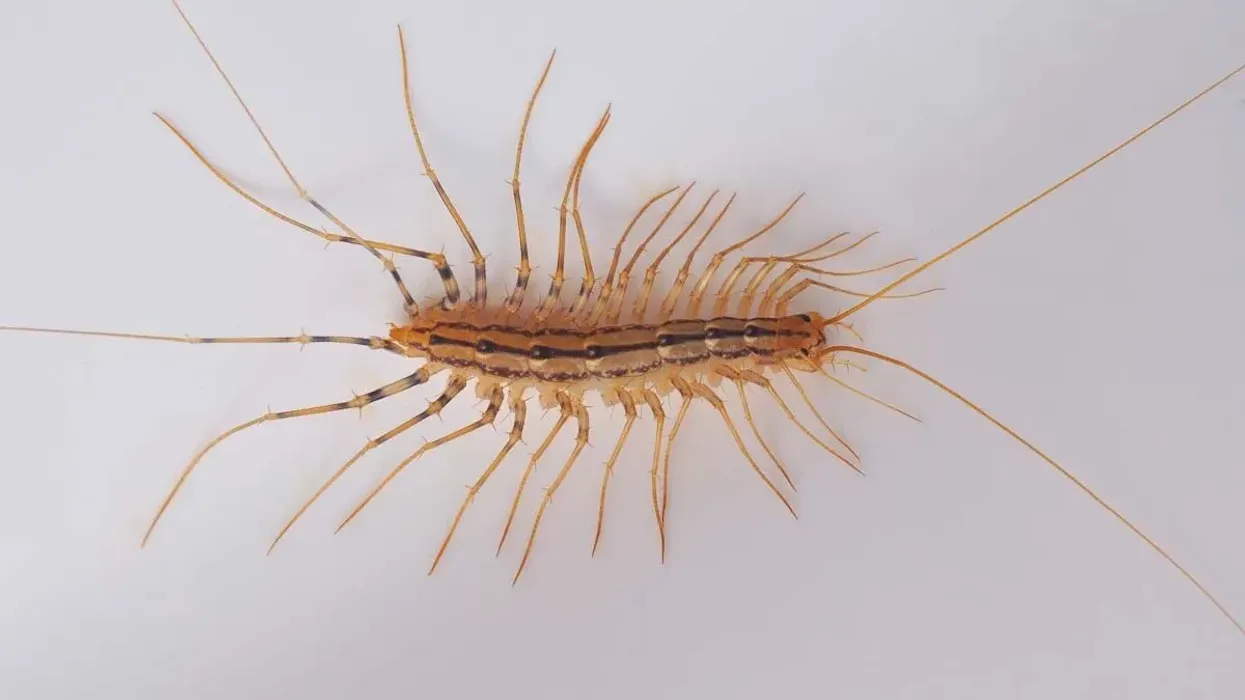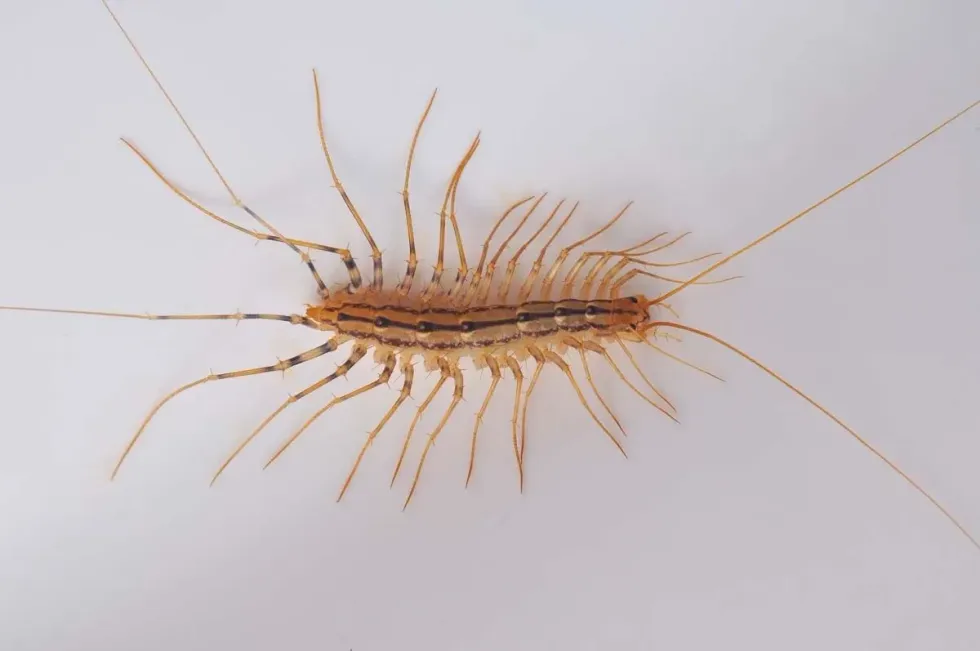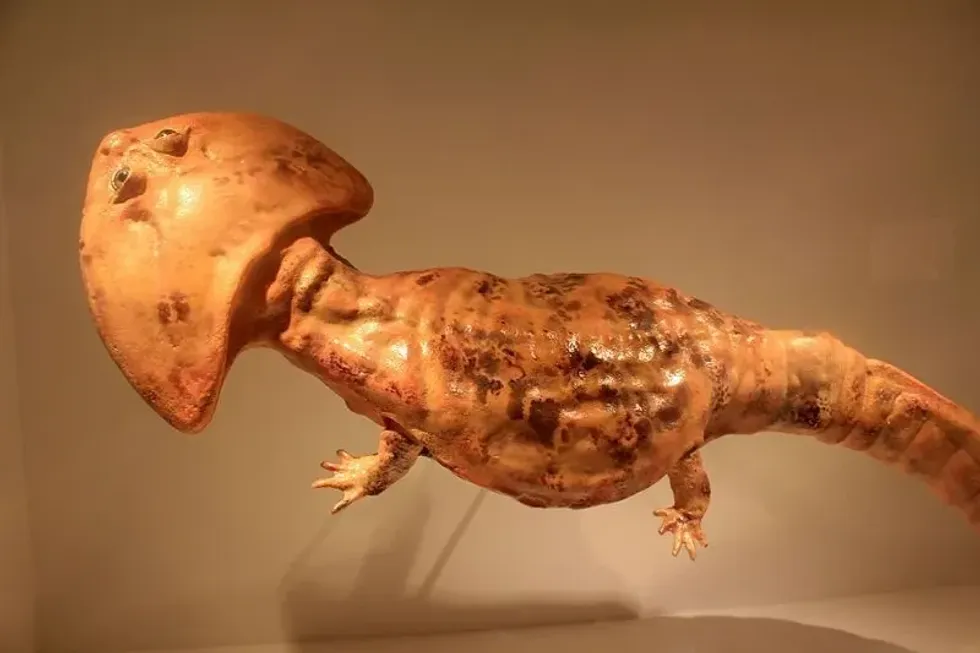House centipedes, scientifically known as Scutigera coleoptrata, is a kind of arthropod that generally prefers humid, damp, and temperate climates. Hence, they are easily found in homes and buildings.
These are yellowish-gray-colored centipedes with three dark stripes and a flattened body with 15 pairs of legs divided into segments and each pair of legs being one segment. Apparently, they are called house centipedes because they prefer the temperature of human homes, especially damp areas such as bathrooms, kitchens, basements.
They have a fuzzy look with long antennae and thin 15 pairs of legs. They have some modified legs called forcipules which help them catch prey by injecting venom.
Their long pairs of legs help them move rapidly and swiftly. The last pair of legs of a female is twice bigger than that of its body.
An adult house centipede is most active during the night. They may enter during the day, but one can never catch them moving as they hide in household closets, and basements.
House centipedes are nocturnal animals that are agile and have really fast speed. They forage for food during the night, and they are seen more often during the spring and autumn season.
They are not aggressive by behavior, and so they don't bite people generally unless provoked.
House centipedes actually have developed eyesight and eyes, but some centipedes do not have eyes, and that is the reason why they use their antennae more often while hunting for their prey. Their main diet or meal of an adult house centipede includes cockroaches, spiders, bugs, silverfish, termites, flies, and insects.
To know more about these fascinating animals, we have gathered a set of interesting information about them for you to read.
House Centipede Interesting Facts
What type of animal is a house centipede?
House centipedes are a type of centipede and come under the classification of arthropods.
What class of animal does a house centipede belong to?
House centipedes belong to the class of Chilopoda.
How many house centipedes are there in the world?
House centipedes have a high rate of reproduction, and so they multiply quickly. Although there is no exact or estimated number of house centipedes, they are spread throughout the world.
Where does a house centipede live?
House centipedes live in a human house or home. They usually crawl and are found in sinks, drains, tubs, running on floors and walls.
What is a house centipede's habitat?
House centipedes prefer a damp and temperate climate. They invade a human's home as they prefer humid and tropical climates. Mainly they live in kitchens, closets, bathrooms, and on the floor of the basement.
Who do house centipedes live with?
House centipedes are solitary arthropods foraging and hunting for food on the damp bathroom, basement floor, or walls, so they are mainly surrounded by insects and termites.
How long does a house centipede live?
A house centipede life cycle has a long life expectancy. They can live up to five to seven years which is considered to be long in arthropods.
How do they reproduce?
House centipedes have high reproductive rates, and so they multiply exponentially. They start mating from the age of three. The male and female house centipedes encompass each other and form a circle.
They attract and communicate with the help of their antennae. The male house centipede draws out his sperm on the ground, and the female house centipede uses them on its own to fertilize her eggs.
A house centipede lays its egg during the spring season. On average, a female house centipede lays around 63-151 eggs. As soon as the eggs hatch, they have four pairs of legs.
What is their conservation status?
House centipede's conservation status is not listed in the IUCN list.
House Centipede Fun Facts
What do house centipedes look like?
House centipedes have a flattened body of yellowish-gray color in appearance and have three dark stripes all across their length, and their legs also have dark stripes. They have soft, delicate 15 pairs of legs with a rigid body that helps them run at a speed of 0.895 mi/h (0.4 m/s).

How gross are they?
House centipedes have big fangs, which are basically their modified legs, and they can be found crawling, running, and climbing on floors and walls. They are squishy, and this is one of the few reasons why they are gross.
How do they communicate?
House centipedes mainly communicate with the help of their antennae and even touch or smell.
How big is a house centipede?
A house centipede is 0.98-1.38 in (2.5-3.5 cm) long in length. Apart from their length, they have long legs and long antennae, which makes them appear three to four inches long. It is around two times bigger than a millipede.
How fast can house centipedes move?
House centipedes are fast runners, and they move swiftly across the floor, walls, and ceilings at a speed of 0.895 mph (0.4 mps).
How much does a house centipede weigh?
These are arthropods, and the weight of an arthropod is very unclear and light, and so they are not generally weighed.
What are their male and female names of the species?
In terms of gender, there has no distinct name for the male and female population of house centipede species. Scientists and experts refer to both males and females as Scutigera coleoptrata or house centipedes.
What would you call a house centipede?
A house centipede does not have any specific name and is referred to by the general name of house centipedes.
What do they eat?
House centipedes are insectivores, and so they eat even the most unwelcome insects and pests of human's home. Their diet or prey includes silverfish, small spiders, cockroaches, crickets, moths, bedbugs, termites, and several other arthropods present in human houses.
Are they harmful?
People often perceive house centipedes as dangerous or harmful, but this is actually a misperception. The fact that they are harmless is very much unknown by most of us.
They are not harmful to humans as their forcipules or their legs containing venom are not strong enough to bite or penetrate the human skin, but they can be a threat to smaller animals like silverfishes. But, they are not a threat to bigger animals such as cats and dogs.
Sometimes, when startled, they may bite people out of self-defense which can be a little painful with a minor swelling resembling a bee's sting.
However, there bites' symptoms disappear after four to five hours or maybe more. Their venom has a lesser impact as it is not that powerful, but in some cases, their bite might cause some harm or allergies from its mild venom.
How rare are they?
They are not really rare as these can be found more often in every damp area of homes.
Did you know...
House centipedes are sometimes kept as pets in the country of Japan.
House centipedes can easily grow their legs back if removed.
They like water, and so they always prefer being around damp areas as they are very prone to dehydration.
Why are they called house centipedes?
They are referred to as house centipedes as they prefer the environment of human houses.
How to get rid of house centipede?
House centipedes are not bad as they are not found eating wood or any of people's household things. Rather, they prey on some unwelcome pests like termites that eat wood which in turn suggests that you should not kill them as they can control the pest population.
These creatures might even crawl up to your beds to eat pests. However, a house centipede bite or seeing a house centipede running across the floors can be really scary. In self-defense, people might kill them.
House centipedes come to your houses as they are attracted by some insects and bugs inside, so getting rid of them would be an initial step. Outdoors, house centipedes are seen on leaves, under rocks and they usually live outdoors in damp areas and keep searching for ways to get into some more humid and suitable climates.
Peppermint oil is one such thing that repels them as they hate the odor of peppermint oil.
Here at Kidadl, we have carefully created lots of interesting family-friendly animal facts for everyone to discover! You can even occupy yourself at home by drawing one on our House centipedes coloring pages.








